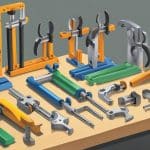Types Of Saws
Saws are a fundamental tool in any woodworking or construction project. There are various types of saws available, each with its own unique features and purposes. Choosing the right saw for the job can make a significant difference in the outcome of the project, so it’s important to understand the various types of saws and their uses.
Hand saws are the most common type of saw and are typically used for cutting wood. They come in various sizes and shapes, including rip saws, crosscut saws, and backsaws. Power saws, on the other hand, are electric or battery-operated and can make quick and precise cuts. They include circular saws, jigsaws, and reciprocating saws. Specialty saws are designed for specific tasks, such as cutting metal or tile.
Understanding saw features and terminology is also crucial when selecting the right saw for the job. Blade length, tooth count, and blade thickness are just a few of the features that can impact the saw’s performance. Additionally, proper maintenance and safety practices can help extend the life of the saw and prevent accidents.
Key Takeaways
- There are various types of saws available, including hand saws, power saws, and specialty saws.
- Understanding saw features and terminology is crucial for selecting the right saw for the job.
- Proper maintenance and safety practices can help extend the life of the saw and prevent accidents.
Hand Saws

Hand saws are manual saws that come in a variety of types. They are commonly used for cutting wood, but some can also cut metal or pipes. The blade of a hand saw typically has teeth that are designed to cut through the material being worked on. The handle of a hand saw is usually ergonomically designed to provide a comfortable grip and to allow for precision cutting. The following are some of the most common types of hand saws:
Back Saws
Back saws are a type of hand saw that have a narrow blade and a stiffening rib along the back of the blade. They are designed for precision cutting and are commonly used for making fine cuts in wood, such as dovetail joints. Back saws typically have a higher number of teeth per inch than other types of hand saws, which allows for more precise cuts.
Japanese Saws
Japanese saws are a type of hand saw that have a thin blade and a handle that is designed to be pulled rather than pushed. They are commonly used in woodworking and are known for their precision and ease of use. Japanese saws typically have teeth that are designed to cut on the pull stroke, which allows for more control over the cut and reduces the risk of the saw binding in the wood.
Coping Saws
Coping saws are a type of hand saw that are designed for cutting curves and intricate shapes in wood. They have a thin blade that is held in place by a frame, which allows for greater maneuverability when cutting. Coping saws typically have a higher number of teeth per inch than other types of hand saws, which allows for more precise cuts.
Hacksaws
Hacksaws are a type of hand saw that are designed for cutting metal and pipes. They have a narrow blade that is held in place by a frame, which allows for greater maneuverability when cutting. Hacksaws typically have teeth that are designed to cut on the push stroke, which allows for more control over the cut and reduces the risk of the saw binding in the metal.
Overall, hand saws are versatile tools that can be used for a variety of cutting tasks. By choosing the right type of hand saw for the job at hand, you can ensure that you get the precision and control you need to make accurate cuts every time.
Power Saws
Power saws are motorized saws that are designed to make cutting through materials faster and more efficient. There are several types of power saws, each with their own unique features and benefits. In this section, we will discuss the most common types of power saws, including circular saws, miter saws, table saws, reciprocating saws, and band saws.
Circular Saws
Circular saws are one of the most commonly used power saws in woodworking projects. They are designed to cut through materials quickly and efficiently, thanks to their circular blade that spins at high speeds. Circular saws can be corded or battery-powered, and they are available in various sizes and styles to suit different projects. They are ideal for cutting lumber, fence posts, and other materials.
Miter Saws
Miter saws are designed to make precise angled cuts. They are commonly used in woodworking and construction projects to create angled cuts for baseboards, crown molding, and other decorative elements. Miter saws can be compound or non-compound, and they are available in corded and battery-powered options.
Table Saws
Table saws are large, powerful saws that are designed to cut through thick materials with ease. They are commonly used in woodworking projects to cut large pieces of lumber or sheet goods. Table saws have an adjustable fence that allows for precise cuts, and they are available in various sizes and styles to suit different projects.
Reciprocating Saws
Reciprocating saws are designed to make rough cuts through materials quickly and efficiently. They are commonly used in demolition and construction projects to cut through walls, pipes, and other materials. Reciprocating saws have a blade that moves back and forth rapidly, allowing them to cut through materials with ease.
Band Saws
Band saws are designed to make precise cuts through materials quickly and efficiently. They are commonly used in woodworking projects to cut curves and other intricate shapes. Band saws have a blade that is held in tension, which allows for efficient cutting. They are available in various sizes and styles to suit different projects, and they can be used with a work table for added efficiency.
Overall, power saws are an essential tool for any woodworking or construction project. They are designed to make cutting through materials faster and more efficient, and they are available in various sizes and styles to suit different projects. When choosing a power saw, it is important to consider factors such as speed, power, and efficiency, as well as the type of blade and materials you will be cutting.
Specialty Saws
Specialty saws are designed to perform specific tasks and are often used by professionals who require precision and accuracy. These saws are usually expensive and require special training to operate.
Scroll Saws
Scroll saws are versatile saws that can make intricate cuts and patterns. They are perfect for cutting curves and other intricate shapes in wood, plastic, and metal. These saws are also used for making jigsaw puzzles, wooden toys, and other crafts. Scroll saws are precise and can make cuts as small as a point.
Tile Saws
Tile saws are used for cutting tiles and are commonly used in the construction industry. These saws use a diamond blade to make precise cuts in ceramic, porcelain, and other types of tiles. Tile saws are also used for cutting other materials such as glass and stone.
Chain Saws
Chain saws are powerful saws that are used for cutting trees and trimming branches. These saws are available in gas and electric models and are commonly used by professionals in the forestry industry. They are also used for cutting firewood and for pruning trees in gardens.
Jigsaws
Jigsaws are versatile saws that can make both straight and curved cuts. They are commonly used for cutting plywood, drywall, and other materials. Jigsaws are lightweight and easy to use, making them a popular choice for DIY enthusiasts.
In summary, specialty saws are designed to perform specific tasks and are often used by professionals who require precision and accuracy. Scroll saws are versatile and can make intricate cuts and patterns, while tile saws are used for cutting tiles and other materials. Chain saws are powerful saws that are used for cutting trees and trimming branches, and jigsaws are versatile saws that can make both straight and curved cuts.
Saw Features and Terminology
Saws come in various shapes and sizes, each designed for specific cutting tasks. Understanding saw features and terminology is essential in selecting the right saw for the job. Here are some key features and terminology to consider:
Teeth
The teeth of a saw blade are responsible for cutting through the material. The number of teeth per inch (TPI) determines the saw’s ability to cut efficiently through different materials. A higher TPI saw blade is suitable for cutting through thinner materials, while a lower TPI blade is suitable for cutting through thicker materials.
Handle
The handle of a saw is an essential component that provides comfort and grip while cutting. The handle can be made of various materials, including wood, plastic, or rubber, and can be designed to fit different hand sizes and shapes.
Blade
The blade of a saw is the part that does the cutting. Different saw blades are designed for different cutting tasks, and they can be made of various materials, including high-carbon steel, stainless steel, and carbide.
Curves and Patterns
Some saws are designed to cut curves and patterns, such as a jigsaw or scroll saw. These saws have a narrow blade that can be easily maneuvered to cut intricate shapes.
Circular Blade
A circular saw is a power saw that uses a circular blade to cut through materials. These saws are commonly used for cutting through wood, metal, and plastic.
Fence
A fence is a guide that helps to keep the saw blade straight while cutting. It is commonly used with table saws and miter saws.
Tension
The tension of a saw blade refers to how tight the blade is stretched. A properly tensioned blade is essential for making accurate cuts and preventing the blade from breaking.
Sawdust
Sawdust is the byproduct of cutting with a saw. It can be hazardous to health if inhaled, so it is essential to use protective gear when cutting with a saw.
Small Holes
Some saws are designed to cut small holes, such as a keyhole saw. These saws have a narrow blade that can be easily inserted into small spaces.
Sturdy and Fixed
Some saws are designed to be sturdy and fixed, such as a band saw. These saws are ideal for making rough cuts through thick materials.
In conclusion, understanding saw features and terminology is crucial in selecting the right saw for the job. Consider the material, cutting task, and saw features before making a purchase.
Choosing the Right Saw for Your Project
When it comes to selecting the right saw for your DIY project, there are several factors to consider. The type of saw you choose will depend on the task at hand, the materials you are working with, and the level of precision required.
For instance, if you are cutting lumber or thick branches, a bow saw may be the best option. This handheld tool is sturdy and can cut through wood with ease. On the other hand, if you need to make precise cuts in metal or plastic pipes, a hacksaw with a C-shaped frame would be a better choice.
For DIYers who want to tackle a variety of projects, a power saw may be the way to go. These motor or gas-powered saws can make quick work of cutting through thick materials and are available in several types, including circular saws, jigsaws, reciprocating saws, and miter saws.
It’s important to note that different saws produce different amounts of sawdust. For example, circular saws tend to produce more sawdust than jigsaws. If you are working indoors, you may want to choose a saw that produces less sawdust to avoid creating a mess.
In summary, when choosing the right saw for your DIY project, consider the following:
- The type of material you are cutting
- The level of precision required
- The amount of sawdust the saw produces
- The type of saw that is best suited for the task at hand
By taking these factors into account, you can select the right saw for your project and achieve the desired results.
Maintenance and Safety
Maintaining and using saws safely is crucial to ensure optimal performance and prevent accidents. Here are some tips for maintaining and using saws safely:
Blade Maintenance
Keeping saw blades sharp is essential for optimal cutting performance. Dull blades can cause the saw to bind and increase the risk of kickback. Blade maintenance involves cleaning the blade after each use, sharpening it regularly, and replacing it when it becomes worn or damaged.
Handle Maintenance
Maintaining the handle of a saw is also important for safety and comfort. Handles should be kept clean and dry to prevent slipping, and any cracks or damage should be repaired or replaced. Additionally, handles should be checked regularly for proper tension to ensure that they are securely attached to the blade.
Motor Maintenance
For power saws, proper motor maintenance is crucial for optimal performance and safety. This involves checking the motor regularly for signs of wear or damage, ensuring that it is properly lubricated, and replacing any worn or damaged parts as needed.
Tension Maintenance
Maintaining proper tension on the blade is important for both manual and power saws. Blades that are too loose can cause the saw to bind, while blades that are too tight can cause excessive wear and tear on the blade and motor. Tension should be checked regularly and adjusted as needed.
Sawdust Management
Sawdust can be a hazard in the workshop, as it can create a fire hazard and cause respiratory problems. Proper sawdust management involves using a dust collection system or wearing a respirator to prevent inhalation of sawdust, as well as cleaning up sawdust regularly to prevent buildup.
Efficiency
Efficiency is important for both manual and power saws. Proper maintenance and use can help to ensure that the saw is cutting efficiently, which can save time and reduce the risk of accidents. This involves using the appropriate blade for the job, maintaining proper tension, and keeping the blade sharp.
Corded and Battery-Powered Saws
When using corded or battery-powered saws, it is important to follow the manufacturer’s instructions for use and maintenance. This includes using the appropriate extension cord for corded saws, and charging batteries properly for battery-powered saws.
Overall, maintaining and using saws safely is crucial for optimal performance and preventing accidents. By following these tips, users can ensure that their saws are cutting efficiently and safely.






